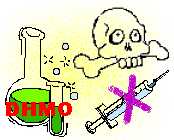http://www.dhmo.org/facts.html#CONCERN
http://www.youtube.com/watch?v=MawlljmaS1w
What are some of the dangers associated with DHMO?
Each year, Dihydrogen Monoxide is a known causative component in many thousands of deaths and is a major contributor to millions upon millions of dollars in damage to property and the environment. Some of the known perils of Dihydrogen Monoxide are: |
|
What are some uses of Dihydrogen Monoxide?
Despite the known dangers of DHMO, it continues to be used daily by industry, government, and even in private homes across the U.S. and worldwide. Some of the well-known uses of Dihydrogen Monoxide are:
- as an industrial solvent and coolant,
- in nuclear power plants,
- by the U.S. Navy in the propulsion systems of some older vessels,
- by elite athletes to improve performance,
- in the production of Styrofoam,
- in biological and chemical weapons manufacture,
- in the development of genetically engineering crops and animals,
- as a spray-on fire suppressant and retardant,
- in so-called "family planning" or "reproductive health" clinics,
- as a major ingredient in many home-brewed bombs,
- as a byproduct of hydrocarbon combustion in furnaces and air conditioning compressor operation,
- in cult rituals,
- by the Church of Scientology on their members and their members' families (although surprisingly, many members recently have contacted DHMO.org to vehemently deny such use),
- by both the KKK and the NAACP during rallies and marches,
- by members of Congress who are under investigation for financial corruption and inappropriate IM behavior,
- by the clientele at a number of bath houses in New York City and San Francisco,
- historically, in Hitler's death camps in Nazi Germany, and in prisons in Turkey, Serbia, Croatia, Libya, Iraq and Iran,
- in World War II prison camps in Japan, and in prisons in China, for various forms of torture,
- during many recent religious and ethnic wars in the Middle East,
- by many terrorist organizations including al Quaeda,
- in community swimming pools to maintain chemical balance,
- in day care centers, purportedly for sanitary purposes,
- by software engineers, including those producing DICOM programmer APIs and other DICOM software tools,
- by popular computer science professors,
- by the semi-divine King Bhumibol of Thailand and his many devoted young working girls in Bangkok,
- by the British Chiropractic Association and the purveyors of the bogus treatments that the BCA promotes,
- by commodities giant Trafigura in their well-publicized and widely-known toxic-waste dumping activities in Ivory Coast,
- in animal research laboratories, and
- in pesticide production and distribution.
